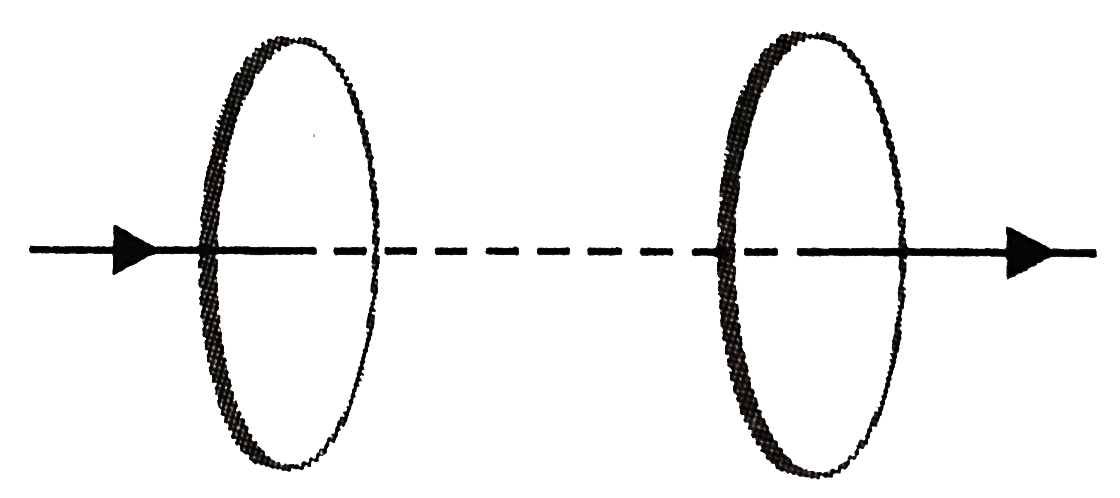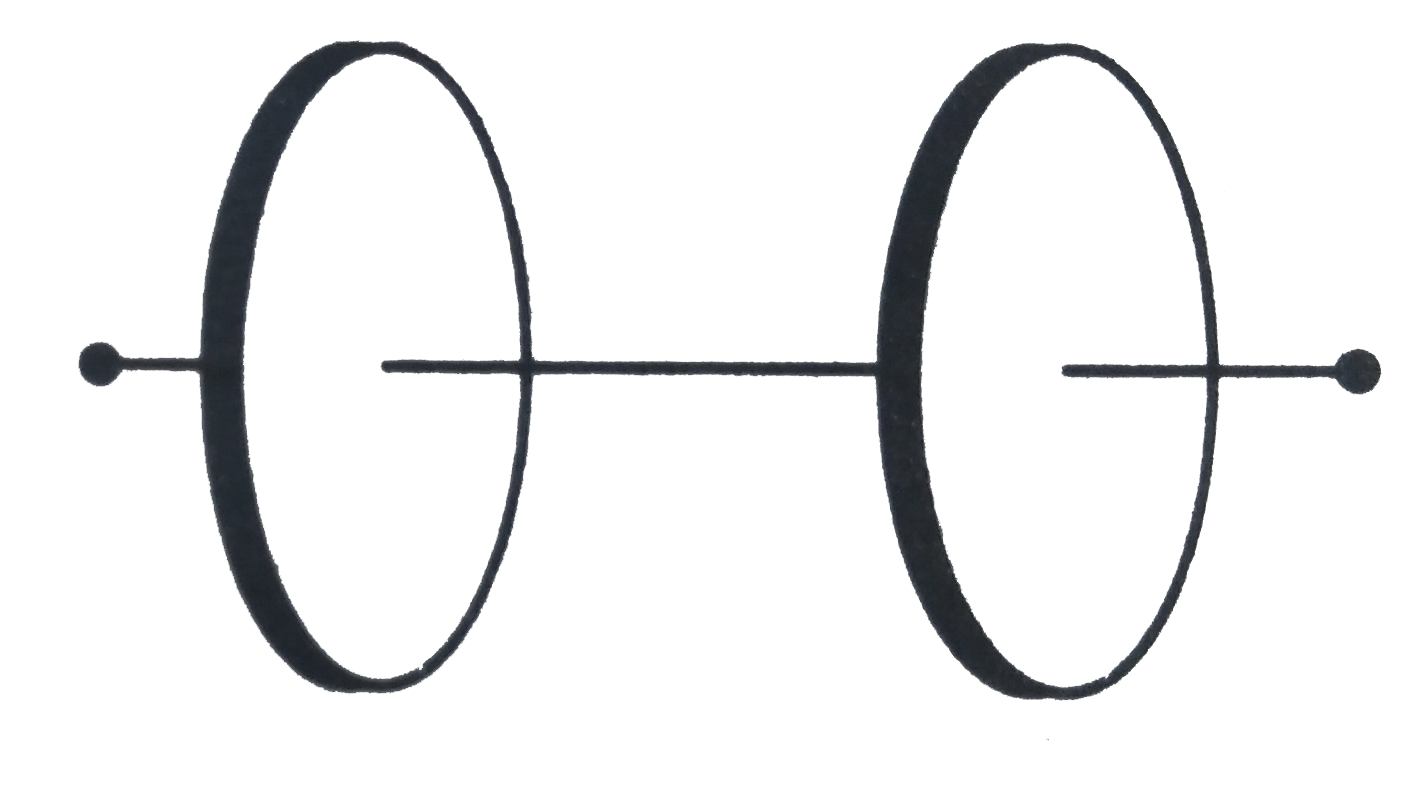A parallel plate capacitor made of two circular plates each of radius 10 cm and separated by 4.0mm. The capacitor is being charged by an external source. The charging current is constant and equal to 0.10A. Calculate (i) the capacitance (ii) the rate of change of potential difference between the plates (iii) the displacement current.
To solve the problem, we will follow these steps:
Step 1: Calculate the Capacitance
The capacitance C of a parallel plate capacitor is given by the formula:
C=ε0⋅Ad
where:
- ε0 is the permittivity of free space, approximately 8.85×10−12F/m,
- A is the area of one of the plates,
- d is the separation between the plates.
First, we need to calculate the area A of the circular plates:
A=πr2
Given that the radius r=10cm=0.1m:
A=π(0.1)2=π(0.01)≈0.0314m2
Now, the separation d=4mm=0.004m.
Now substituting the values into the capacitance formula:
C=(8.85×10−12)⋅(0.0314)0.004≈2.7769×10−130.004≈6.94225×10−11F≈69.42pF
Step 2: Calculate the Rate of Change of Potential Difference
The relationship between the charging current I, capacitance C, and the rate of change of potential difference dVdt is given by:
I=CdVdt
Rearranging this gives:
dVdt=IC
Substituting the known values I=0.10A and C≈69.42×10−12F:
dVdt=0.1069.42×10−12≈1.44×1010V/s
Step 3: Calculate the Displacement Current
The displacement current Id is defined as:
Id=ε0dΦEdt
where ΦE is the electric flux. For a capacitor, the displacement current is equal to the charging current I:
Id=I=0.10A
Final Answers
1. Capacitance: C≈69.42pF
2. Rate of change of potential difference: dVdt≈1.44×1010V/s
3. Displacement current: Id=0.10A
The capacitance C of a parallel plate capacitor is given by the formula:
- ε0 is the permittivity of free space, approximately 8.85×10−12F/m,
- A is the area of one of the plates,
- d is the separation between the plates.
The relationship between the charging current I, capacitance C, and the rate of change of potential difference dVdt is given by:
The displacement current Id is defined as:
1. Capacitance: C≈69.42pF
2. Rate of change of potential difference: dVdt≈1.44×1010V/s
3. Displacement current: Id=0.10A
Topper's Solved these Questions
- BOOK - PRADEEPCHAPTER - ELECTROMAGNETIC WAVESEXERCISE - Solved Example4videos
ELECTROMAGNETIC WAVES
- BOOK - PRADEEPCHAPTER - ELECTROMAGNETIC WAVESEXERCISE - (I) Conceptual problems1videos
ELECTROMAGNETIC WAVES
- BOOK - PRADEEPCHAPTER - ELECTROMAGNETIC INDUCTION & ALTERNATING CURRENTEXERCISE - Multiple Choice Questions1videos
ELECTROMAGNETIC INDUCTION & ALTERNATING CURRENT
- BOOK - PRADEEPCHAPTER - ELECTRONIC DEVICESEXERCISE - Fill in the Blanks1videos
ELECTRONIC DEVICES
Similar Questions
Fig. shows a capacitor made of two circular plates each of radius 12 cm and separated by 5.0mm. The capacitor is being charged by an external source (not shown in the figure). The charging current is constant and equal to 0.15A.
(a) Calculate the capacitance and the rate of change of potential difference between the plates.
(b) Obtain the displacement current across the plates.
(c) Is Kirchhoff's first rule valid at each plate of the capacitor ? Explain.
 View Solution
View SolutionA capacitor consists of two circular plates each of radius 8.0 cm and separated by 3.0 mm. The capacitor is being charged by an external battery. The charging current is constant and is equal to 0.3 A. Calculate (i) capacitance of capacitor, (ii) the rate of change of potential difference across the plates of capacitor and (iii) the displacement current.
View Solution
Knowledge Check
- Question 1 - Select One
A capacitor made of two circular plates each of radius 12 cm and separated by 5 mm. The capacitor is being charged by an external source. The charging current is constant and equal to 0.15 A. The capacitance of the parallel plate capacitor is
 A40 pFB45 pFC70 pFD80 pF
A40 pFB45 pFC70 pFD80 pF - Question 2 - Select One
A parallel plate capacitor consists of two circular plates each of radius 12cm and separated by 5.0mm. The capacitor is being charge by an external source. The charging current is constant and is equal to 0.15 A. The rate of change of potential difference between the plate will be
A8.173×107Vs−1B7.817×108Vs−1C1.173×109Vc−1D3.781×1010Vs−1
Figure 8.01 shows a capacitor made of two circular plates each of radius 12 cm, and separated by 5.0 cm. The capacitor is being charged by an external source (not shown in the figure). The charging current is constant and equal to 0.15 A.
(a) Calculate the capacitance and the rate of charge of potential difference between the plates.
(b) Obtain the displacement current across the plates.
(c) Is Kirchhoff.s first rule (junction rule) valid at each plate of the capacitor? Explain.
 View Solution
View SolutionFigure shows a capacitor made of two circular plates each of radius 12cm, and separated by 5.0cm. the capacitor is being charged by an external source (not shown in the figure). The charging current is constant and equal to 0.15A
(a) Calcuate the capacitance and the rate of change of potential difference between the plates
(b) Obtain the displacement current across the plates
(c) Is kirchhoff's first rule(junction rule) vaild at each plate of the capacitor ? Explain.
 .View Solution
.View Solution(a) Fig shows a capacitor made of two circular plates each of radius 12cm and separated by 5.0mm. The capacitor is being charged by an external source (not shown in the figure). The charging current is constant and equal to 0.15A. Use Ampere's law (modified to include displacement current as given in the text) and the symmetryin the problem to calculate magnetic field between the plates at a point (i) on the axis (ii) 6.5 cm from the axis (iii) 15cm from the axis.
(b) At what distance from the axis is the magnetic field due to displacement current greatest? Obtain the maximum value of the field. View Solution
View SolutionA parallel plate capacitor is made out of two rectangular metal pates of sides 30cm×15cm and separated by a distance of 2.0 mm. The capcitor is charged in such a way that the charging current has a constant value of 100mA. What must be the rate of change of potential of the charging source to ensure this and what will be the displacement current in the region between the capacitor plates?
View SolutionA capacitor, made of two parallel plates each of plate area A and separation d, is being charged by an external ac socurce. Show that the displacement current inside the same as the current charging the capacitor.
View SolutionA parallel plate capacitor has two circular plates each of radius 5 cm separated by a distance of 3 m m . The capacitor current of 6 A is delived to it , find
(a) The capacitance
(b ) The rate of change of potential difference across the plates
(c ) the displacement current .View Solution

